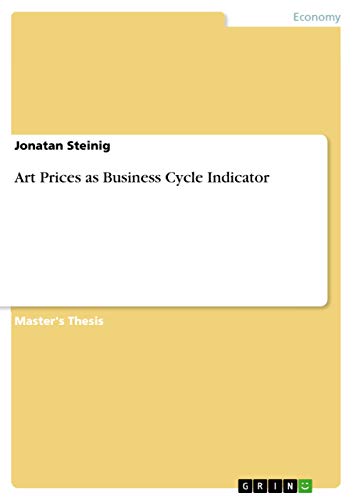Items related to Art Prices as Business Cycle Indicator

"synopsis" may belong to another edition of this title.
- PublisherGRIN Verlag
- Publication date2015
- ISBN 10 3668004366
- ISBN 13 9783668004368
- BindingPaperback
- Number of pages88
Buy New
Learn more about this copy
Shipping:
£ 19.71
From Germany to U.S.A.
Top Search Results from the AbeBooks Marketplace
Art Prices as Business Cycle Indicator
Book Description Taschenbuch. Condition: Neu. This item is printed on demand - it takes 3-4 days longer - Neuware -Master's Thesis from the year 2015 in the subject Economics - Macro-economics, general, grade: 1,0, University of Hamburg, language: English, abstract: 'When bankers get together for dinner, they discuss Art. When artists get together for dinner they discuss money.' (Oscar Wilde)Works of art are unique and highly heterogeneous but if they are traded, they share the common purpose of creating income. However, not only artists will discuss money at dinner, also bankers while they discuss art, are likely to talk about financial gains through investments in art. In economics a small group of researchers has examined whether this kind of investment is profitable or not. Although findings are not consistent, some authors conclude that art, compared to equity or bonds, does perform relatively well and offers diversification benefits in investment portfolios. Despite the inconsistency of findings, this research has led to a growing interest in art investment. Promoters of art investment like art investment funds work on a transformation of art into a new and widely accepted asset class, which they hope will prospectively be included in investment portfolios in the same way as real estate (Picinati di Torcello (2012): 15). Investment in art is determined by the expected price appreciation of art works in the future (Stein (1977): 1021). The quantity of original artworks, at least by deceased artists, cannot be augmented and the elasticity of supply is zero (Baumol (1986): 10). The future prices of art works as investment goods will thus depend on demand as well as on wealth of individuals and institutions at the sales date (Goetzmann (1993): 1371). The greater the purchasing power of prospective buyers, the more art is being bought and the higher art prices will be (Goetzmann et al. (2009): 2). Consequently art prices are expected to react to changes in economic prosperity and to fluctuate in the course of the business cycle. Business cycle research is a vital branch of macroeconomics and many theories and studies exist which examine the boom and bust periods of the economy as different phases of business cycles. Contrary there is little research which looks at 'the link between the art market and the broader economy' (ibid: 4).This master thesis aims at contributing insights on this link by analysing the behavior of art prices under different macroeconomic conditions. Precisely, the objective is to assess the characteristics of art prices as business cycle indicator for the U.S. economy. [.] 88 pp. Englisch. Seller Inventory # 9783668004368
Art Prices as Business Cycle Indicator
Book Description Taschenbuch. Condition: Neu. Druck auf Anfrage Neuware - Printed after ordering - Master's Thesis from the year 2015 in the subject Economics - Macro-economics, general, grade: 1,0, University of Hamburg, language: English, abstract: 'When bankers get together for dinner, they discuss Art. When artists get together for dinner they discuss money.' (Oscar Wilde)Works of art are unique and highly heterogeneous but if they are traded, they share the common purpose of creating income. However, not only artists will discuss money at dinner, also bankers while they discuss art, are likely to talk about financial gains through investments in art. In economics a small group of researchers has examined whether this kind of investment is profitable or not. Although findings are not consistent, some authors conclude that art, compared to equity or bonds, does perform relatively well and offers diversification benefits in investment portfolios. Despite the inconsistency of findings, this research has led to a growing interest in art investment. Promoters of art investment like art investment funds work on a transformation of art into a new and widely accepted asset class, which they hope will prospectively be included in investment portfolios in the same way as real estate (Picinati di Torcello (2012): 15). Investment in art is determined by the expected price appreciation of art works in the future (Stein (1977): 1021). The quantity of original artworks, at least by deceased artists, cannot be augmented and the elasticity of supply is zero (Baumol (1986): 10). The future prices of art works as investment goods will thus depend on demand as well as on wealth of individuals and institutions at the sales date (Goetzmann (1993): 1371). The greater the purchasing power of prospective buyers, the more art is being bought and the higher art prices will be (Goetzmann et al. (2009): 2). Consequently art prices are expected to react to changes in economic prosperity and to fluctuate in the course of the business cycle. Business cycle research is a vital branch of macroeconomics and many theories and studies exist which examine the boom and bust periods of the economy as different phases of business cycles. Contrary there is little research which looks at 'the link between the art market and the broader economy' (ibid: 4).This master thesis aims at contributing insights on this link by analysing the behavior of art prices under different macroeconomic conditions. Precisely, the objective is to assess the characteristics of art prices as business cycle indicator for the U.S. economy. [.]. Seller Inventory # 9783668004368

